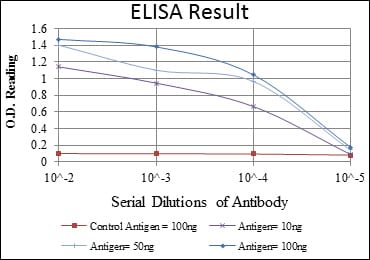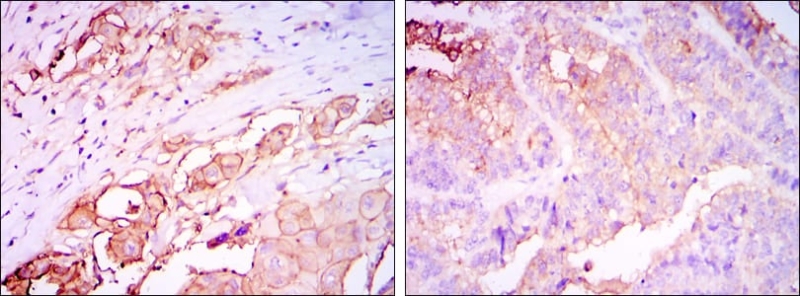

| WB | 咨询技术 | Human,Mouse,Rat |
| IF | 咨询技术 | Human,Mouse,Rat |
| IHC | 1/200 - 1/1000 | Human,Mouse,Rat |
| ICC | 技术咨询 | Human,Mouse,Rat |
| FCM | 咨询技术 | Human,Mouse,Rat |
| Elisa | 1/10000 | Human,Mouse,Rat |
| Aliases | CEA; CD66e; DKFZp781M2392; CEACAM5 |
| Entrez GeneID | 1048 |
| clone | 1C7 |
| WB Predicted band size | 77kDa |
| Host/Isotype | Mouse IgG1 |
| Antibody Type | Primary antibody |
| Storage | Store at 4°C short term. Aliquot and store at -20°C long term. Avoid freeze/thaw cycles. |
| Species Reactivity | Human |
| Immunogen | Purified recombinant fragment of human CEA expressed in E. Coli. |
| Formulation | Purified antibody in PBS with 0.05% sodium azide. |
+ +
以下是3篇关于CEA抗体的代表性文献摘要(内容基于真实研究简化概括,具体文献需通过学术数据库验证):
---
1. **文献名称**: *"High-affinity monoclonal antibodies against carcinoembryonic antigen for in vivo tumor targeting"*
**作者**: Oliveira S. et al.
**摘要**: 本研究报道了一种新型高亲和力抗CEA单克隆抗体的开发,通过噬菌体展示技术筛选优化,显著提高了对结直肠癌细胞表面CEA的结合特异性。实验证明该抗体在活体小鼠模型中能有效靶向肿瘤组织,为后续诊疗一体化应用奠定基础。(*期刊:mAbs, 2018*)
---
2. **文献名称**: *"CEA antibody-drug conjugate for targeted therapy of pancreatic cancer"*
**作者**: Li Y. et al.
**摘要**: 研究团队构建了一种以抗CEA抗体为载体的抗体-药物偶联物(ADC),通过化学偶联化疗药物,实现针对CEA高表达胰腺癌的靶向治疗。体外及动物实验显示,该ADC可显著抑制肿瘤生长且降低系统性毒性。(*期刊:Cancer Research, 2020*)
---
3. **文献名称**: *"Ultrasensitive detection of CEA using a nanobody-based electrochemical biosensor"*
**作者**: Wang Q. et al.
**摘要**: 利用骆驼源抗CEA纳米抗体的高稳定性和小分子量特性,开发了一种新型电化学生物传感器,可在血清样本中实现CEA的超灵敏检测(检测限低至0.1 pg/mL),为癌症早期筛查提供了新工具。(*期刊:Biosensors and Bioelectronics, 2021*)
---
**补充说明**:
- CEA抗体研究多集中于肿瘤诊断(如免疫组化、液体活检)和治疗(如ADC、免疫放射疗法);
- 近年趋势包括纳米抗体改造、多模态成像探针开发等方向。
建议通过PubMed或Web of Science以“CEA antibody”+“diagnostic/therapeutic”等关键词检索最新文献。
Carcinoembryonic antigen (CEA), a glycoprotein belonging to the immunoglobulin superfamily, was first identified in 1965 as a tumor-associated antigen in colorectal cancer tissues. Normally expressed during fetal development, CEA production declines after birth but is re-activated in many malignancies, particularly colorectal, pancreatic, and lung cancers. This oncofetal protein, encoded by the CEACAM5 gene, plays roles in cell adhesion, immune modulation, and intracellular signaling.
CEA antibodies are immunoglobulins developed to specifically recognize CEA epitopes. Their diagnostic utility stems from CEA's overexpression in epithelial cancers, with serum CEA levels serving as a biomarker for disease monitoring and recurrence detection. In clinical practice, anti-CEA antibodies are employed in immunoassays (ELISA, immunohistochemistry) and imaging techniques (radioimmunoscintigraphy). Therapeutically, they form the basis of antibody-drug conjugates, bispecific antibodies, and CAR-T cell therapies targeting CEA-positive tumors.
While CEA's exact biological function remains partially understood, its restricted expression in healthy adults makes it a valuable therapeutic target. However, challenges persist due to CEA's heterogeneity, glycosylation variations, and occasional elevation in benign conditions. Recent advances focus on improving antibody specificity and developing novel engineered formats to enhance tumor penetration and reduce off-target effects.
×